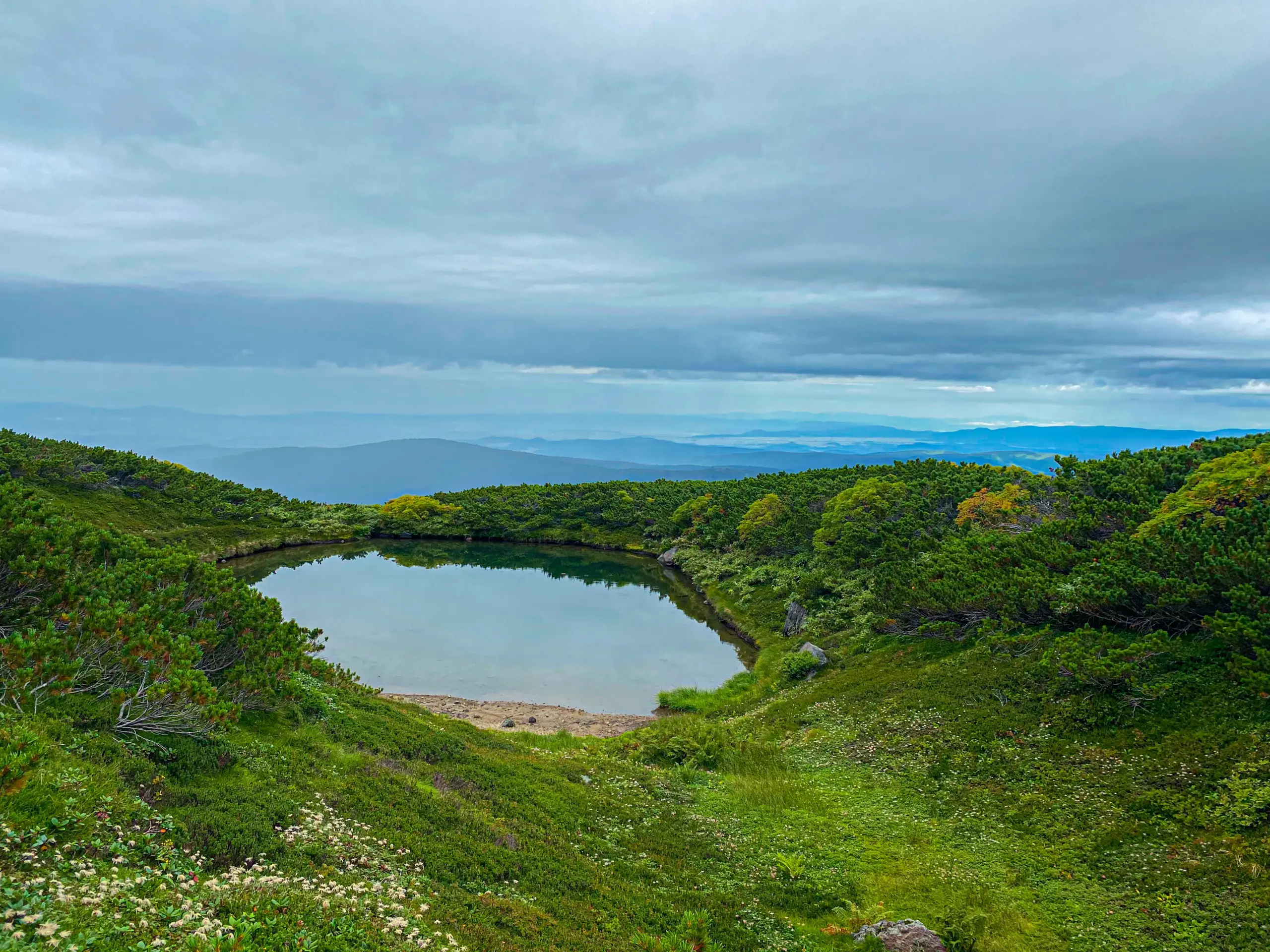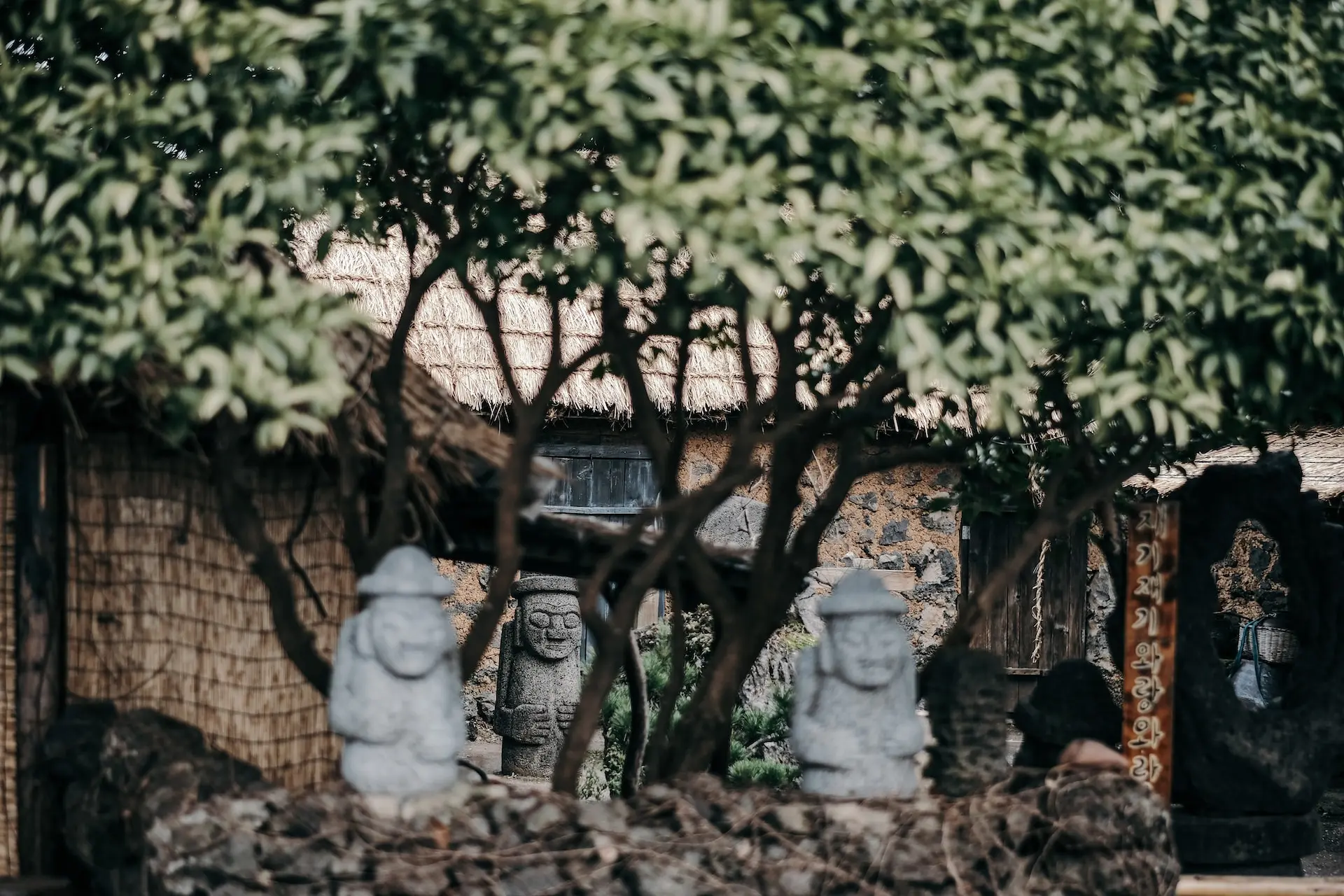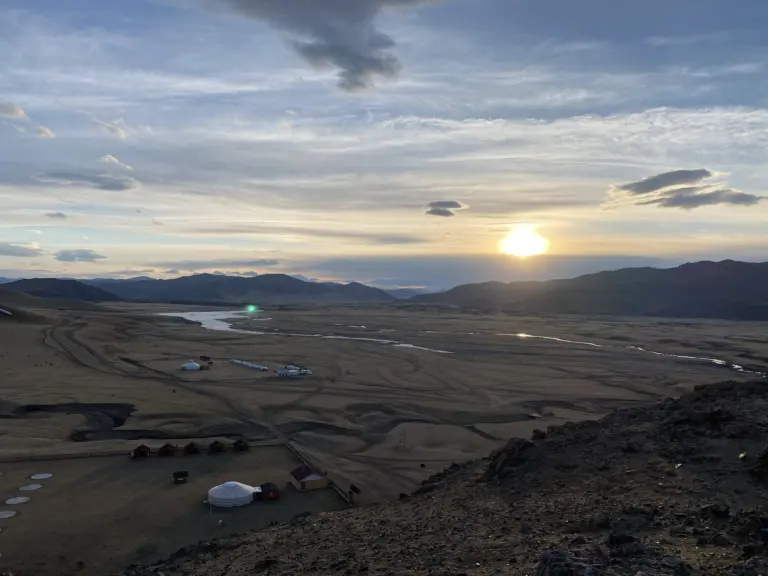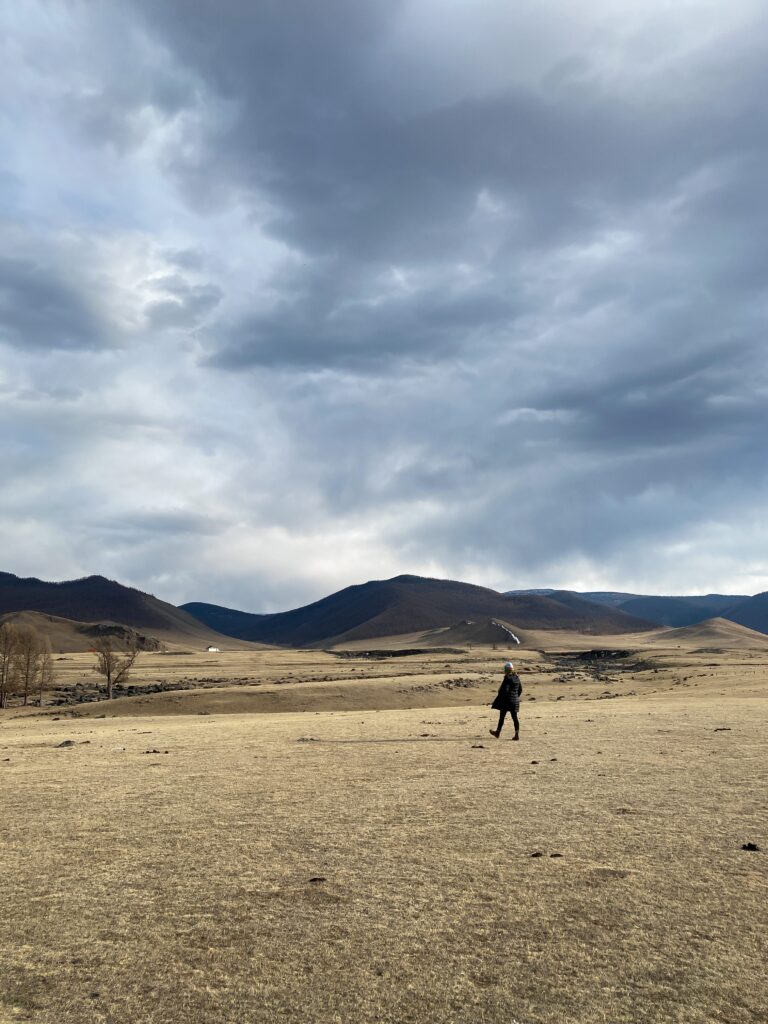Delphi, the Navel of the World.
Nestled on the slopes of Mount Parnassus, Delphi exudes a mystical aura that is bound to enchant.
As a UNESCO World Heritage Site, it transcends archaeology, standing as a timeless sanctuary of human spirituality and the search for divine wisdom.
Once, kings and commoners alike made pilgrimages here, seeking counsel from the famed Oracle of Delphi.
To walk the Sacred Way is to be part of an unbroken continuum, to share in beliefs that have shaped human civilization.
The air is thick with the imagined echoes of hymns sung, laurel wreaths awarded, and prophesies declared. It invites us all to question, to ponder, and to seek our own truths, just as it did in antiquity.
Table of Contents
Toggle
What to Know About Delphi
Delphi is located in central Greece, on the southwestern spur of Mount Parnassus in the valley of Phocis. It’s approximately 180 km (112 mi) northwest of Athens.
The site is situated at an altitude ranging from 550 to 640 m (1804 – 2100 ft) above sea level.
Ticket Price for Delphi Archaeological Site and Museum: 12 EUR

The Oracle of Delphi
The Oracle of Delphi was a priestess known as the Pythia, who served as the intermediary between humans and the god Apollo.
The Pythia would enter a trance-like state, induced by inhaling the fumes of burning laurel leaves and barley meal, which were believed to emanate from a chasm in the temple floor. While in this state, the Pythia would utter prophecies, often in a cryptic form. These were then usually interpreted by the priests of the temple and relayed to the inquirer.
It’s said that even Alexander the Great consulted the Oracle to confirm his divine protection in his military campaigns!
The Navel of the World
According to the myth, Zeus, the king of gods, sent two eagles flying from opposite ends of the world, and they met in Delphi, signifying it as the world’s center. To mark this divine ordination, an omphalos stone was placed at the site.
This stone was believed to enable direct communication with the gods and you can find it at the Archaeological Museum.

History of Delphi
Delphi was initially associated with the worship of Gaia, the Earth goddess, and guarded by a serpent called Python. However, it gained prominence primarily as the sanctuary of Apollo, the god of prophecy, music, and healing.
In Greek Mythology, Apollo is said to have slain Python and claimed Delphi for himself. From that point on, the Temple of Apollo became the central structure in the sanctuary, and it housed the Delphic Oracle.
The Amphictyonic League, a federation of Greek tribes, was centered around the temple and governed the operation of the Oracle and the organization of the Pythian Games. These games, held every four years, were one of the four Panhellenic Games of ancient Greece and included competitions in music, poetry, and athletics.
However, Delphi’s influence began to wane during Roman times, especially under the rule of Emperor Theodosius I, who ordered the closure of all pagan temples in 393 CE.
The site fell into disrepair during the Byzantine era and was ultimately abandoned. It wasn’t until the late 19th century that systematic excavations began, uncovering the rich archaeological treasures that had been buried for centuries.
Top Things to Do in Delphi

1. Take a Road Trip to Delphi
The drive to Delphi takes you through the heart of Greece and offers amazing mountainous scenery. The journey usually takes around 2.5 to 3 hours if you’re coming from Athens. It’s what we did and it was honestly one of my main highlights for Greece!
One route option includes the National Road 48, which will take you through Livadeia and Arachova, towns known for their picturesque landscapes and rich history. Arachova, in particular, is worth a stop; it’s a mountain town famous for panoramic views of the surrounding hills. Arachova is just a short 10-minute drive from Delphi, and the scenery along the way is dramatic, to say the least.
The road trip to Delphi is not just a means to an end, but an integral part of the experience. It offers the opportunity to see Greece from a different vantage point and to take impromptu detours that allow for exploration.
Plus, the anticipation builds as you climb the mountain roads, making your arrival at the sacred site of Delphi all the more rewarding. If driving isn’t your thing, you can also join a Guided Tour to Delphi.
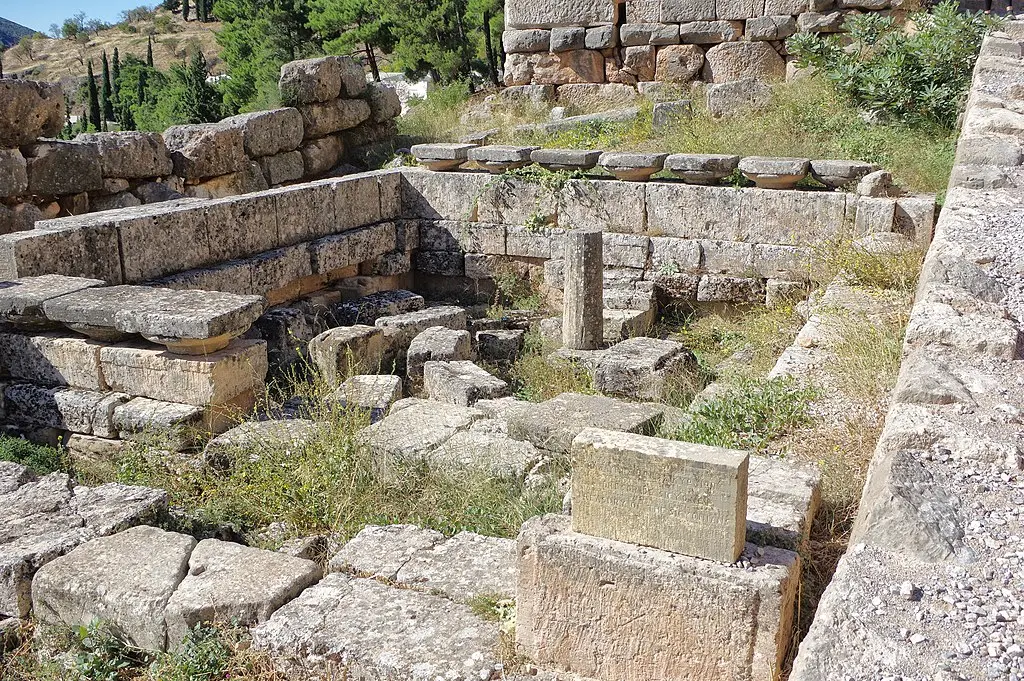
2. Check Out the Sikyonian Treasury
The Sikyonian Treasury was built by the city-state of Sikyon, located in the northern Peloponnese, as a symbol of their devotion and gratitude to Apollo.
Constructed in the 6th century BCE, the Sikyonian Treasury was made from porous limestone originally and later converted to marble. While much of the original structure hasn’t survived, it’s still amazing to imagine the structures that once stood there.

3. Pray at the Temple of Apollo
Constructed in the 4th century BCE, replacing earlier versions that were destroyed by fire and earthquakes, the Temple of Apollo is located on a terraced slope and just like the Temple of Apollo Karneios in Santorini, it’s set against a dramatic backdrop of the mountains and it’s an epitome of Greek culture.
Constructed using porous limestone quarried from the nearby Mt. Parnassus, the temple originally featured 6 columns on the short sides and 15 on the long sides.
Inside the temple was the adyton, a restricted sanctuary that was the center of the Oracle’s activities. This inner chamber housed an eternal flame, symbolizing the eternal wisdom of Apollo, as well as the omphalos, a stone that represented the “navel of the world.”
Don’t miss the inscribed maxims, such as “Know Thyself” and “Nothing in Excess,” attributed to the Seven Sages of Greece.
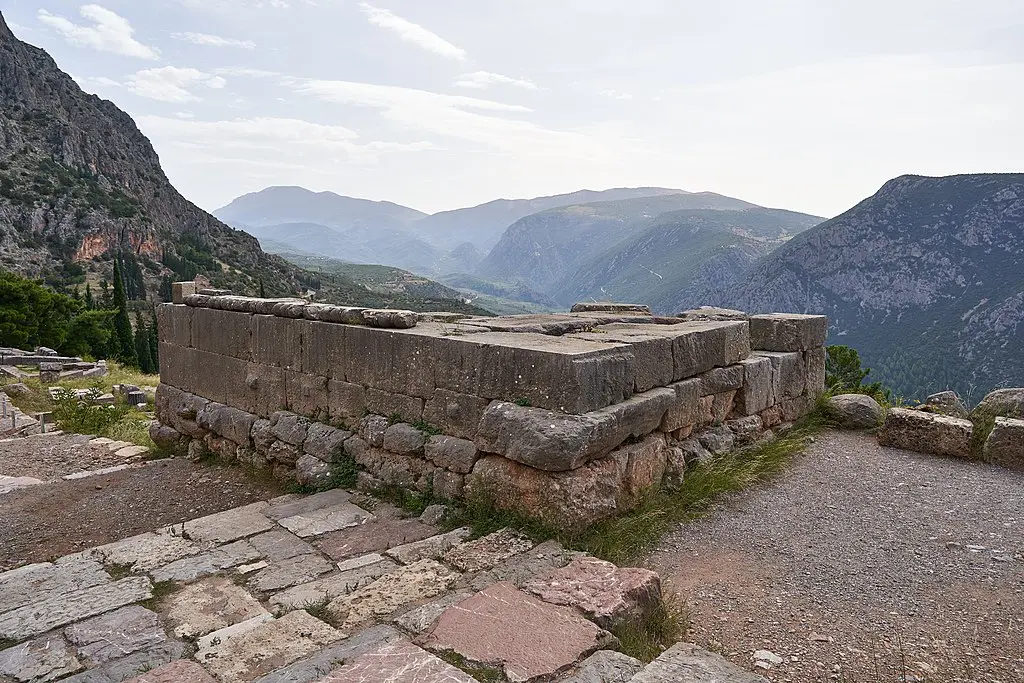
4. Don't Miss the Siphnian Treasury
Another treasury that you will find right acrossthe Sikyonian Treasury. Funded by the city-state of Siphnos, which was then flush with wealth from its gold and silver mines, this treasury was erected around 525 BCE. This particular treasury was constructed in the Ionic architectural order, distinguished by its slender, fluted pillars and elaborate ornamentation.
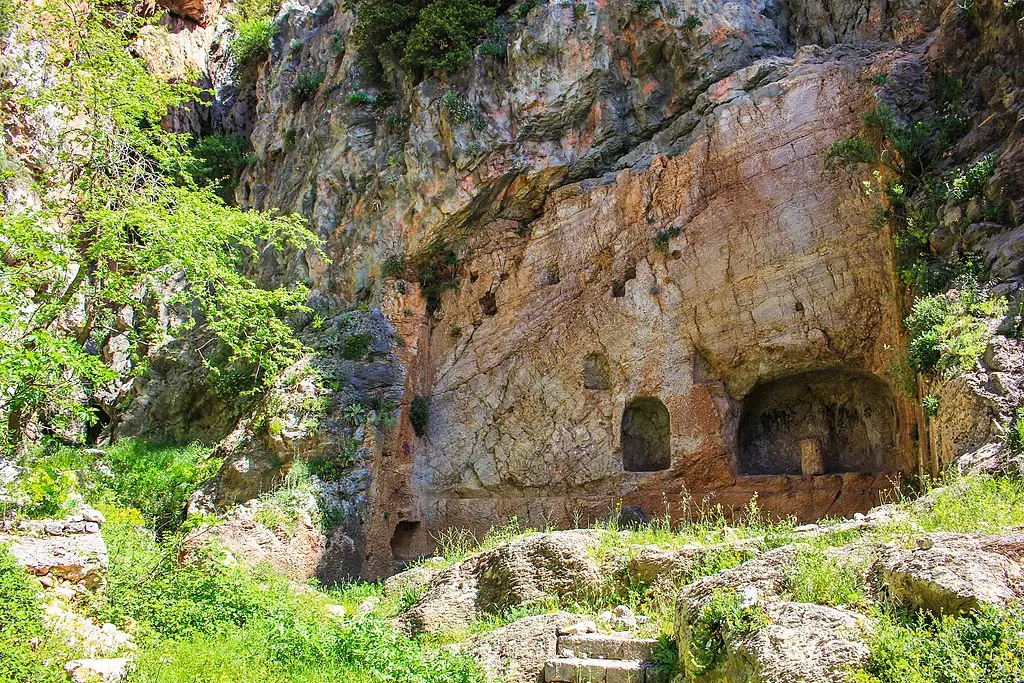
5. Get Cleansed at Castalia Spring
The Castalia Spring is found between the archaeological site and the modern town, this spring has been a symbol of purification and inspiration since ancient times.
The spring is named after Castalia, a nymph who was transformed into the spring by Apollo. In ancient times, pilgrims who came to consult the Oracle of Delphi would first purify themselves in the waters of the Castalia Spring, as it was believed that the water had sanctifying properties.
Even the Oracle herself would bathe here before she entered the temple.
The spring emanates from the Phaedriades cliffs, and the water flows down into a stone basin. According to hydrogeological studies, the water from Castalia Spring originates from the surrounding Parnassus mountain ranges, filtered through limestone and karst formations before it reaches the basin.
A trip to Castalia Spring allows you to touch and drink the same waters that have flowed for thousands of years!

6. Find a Serpent at the Tripod of the Plataeans
The Tripod of the Plataeans was erected to commemorate the victory of the Greek city-states over the Persians at the Battle of Plataea in 479 BCE. Nowadays however, you’ll find a serpentine column instead, and a replica to boot.
The Plataeans, who were among the participants in this decisive conflict, dedicated the monument as a votive offering to Apollo. The victory at Plataea effectively ended the second Persian invasion led by King Xerxes, and the tripod served as a symbol of collective Greek valor.
The tripod was also an emblem of Panhellenic unity since the Battle of Plataea involved an alliance of several Greek city-states, overcoming internal divisions to fend off a common enemy.

7. Spot the Metopes on The Athenian Treasury
The Athenian Treasury stands as one of the more famous structures in the sanctuary of Delphi. Built between 510 and 480 BCE, it was constructed to commemorate the Athenians’ victory at the Battle of Marathon.
Made from Parian marble, a high-quality marble sourced from the island of Paros, the treasury has an elegant Doric design characterized by stout columns and simple geometric forms which was often associated with the mainland Greeks, particularly the Spartans and Athenians.
Perhaps one of the most famous aspects of the Athenian Treasury was its metopes, the decorative panels situated above the columns. These metopes were intricately carved with scenes from the labors of Heracles and Theseus—two heroes closely linked to the city of Athens.

8. Soak in the Sights at the Ancient Theatre of Delphi
The theatre, constructed around the 4th century BCE, is situated on a hill providing a panoramic view of the entire sanctuary and the valley beyond. The theatre could originally seat about 5,000 spectators and was primarily used for the performance of plays during the Pythian Games.
The Romans later modified it to suit their taste for grandeur, adding more rows for increased seating capacity and a sturdier skene (stage building). Even today, you can still see the remains of the orchestra, the circular space where the chorus would perform, which has a diameter of about 7 m (around 22 ft).
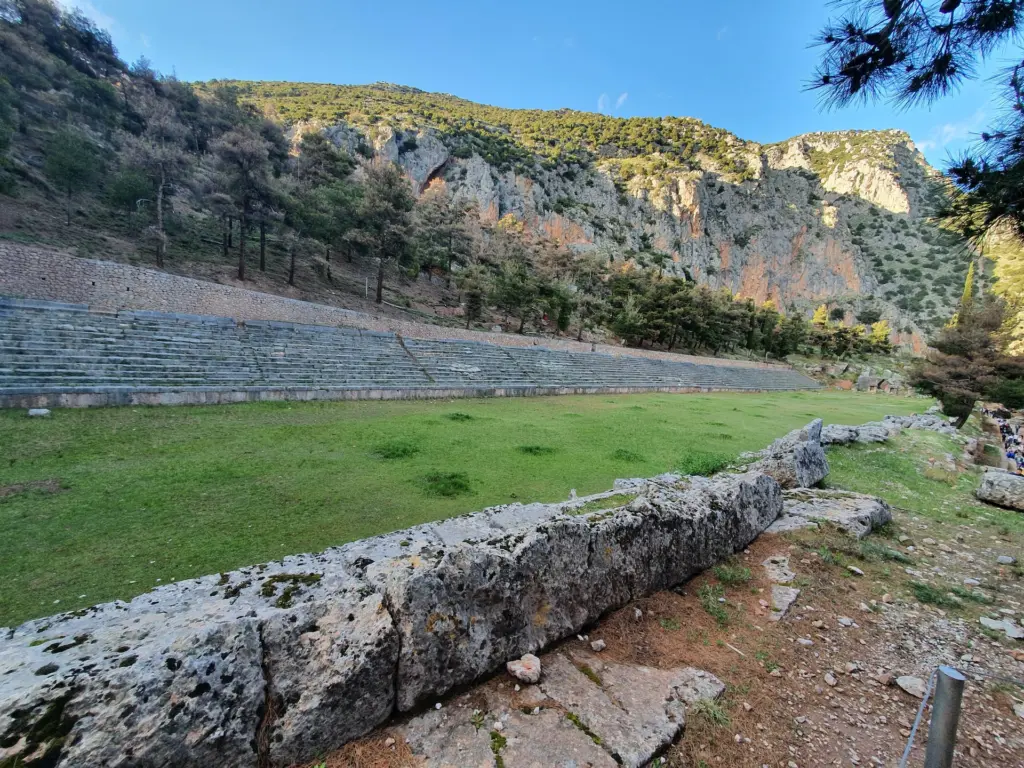
9. Get Pumped at the Ancient Stadium of Delphi
At the highest point of the sanctuary of Apollo, lies the Ancient Stadium of Delphi. You’ll have to do a tiny but easy hike to reach this vantage point.
Originally constructed in the 5th century BCE, the stadium underwent significant renovations, particularly in the 2nd century CE under the patronage of Herodes Atticus, a wealthy Athenian.
The Stadium of Delphi is approximately 178 m long and 25.5 m wide (584 by 83.6 ft) and could accommodate around 7,000 spectators. The stadium is unique in its shape; it’s U-shaped with a stone platform at the rounded end, known as the “exedra,” where officials would sit.
Athletes would compete in a variety of events here, including foot races, long-jump, shot put, and discus throwing.

9. Learn History at the Delphi Archaeological Museum
Located just a few hundred meters from the main archaeological site, this museum houses some of the most important artifacts and statues discovered during the excavations at Delphi.
It’s a modern building, inaugurated in 1903 but significantly expanded and renovated since, with the latest major update in 1999. The museum offers a chronological walkthrough of the site’s rich history, covering a period from the Mycenaean era to the late antiquity, around the 4th century CE.
One of the most iconic pieces in the museum is the Charioteer of Delphi, also known as the “Heniokhos.” This life-size bronze statue is considered a prime example of ancient Greek sculpture. The statue was found in 1896 and is remarkably well-preserved, retaining even the glass inlays that serve as the charioteer’s eyes.
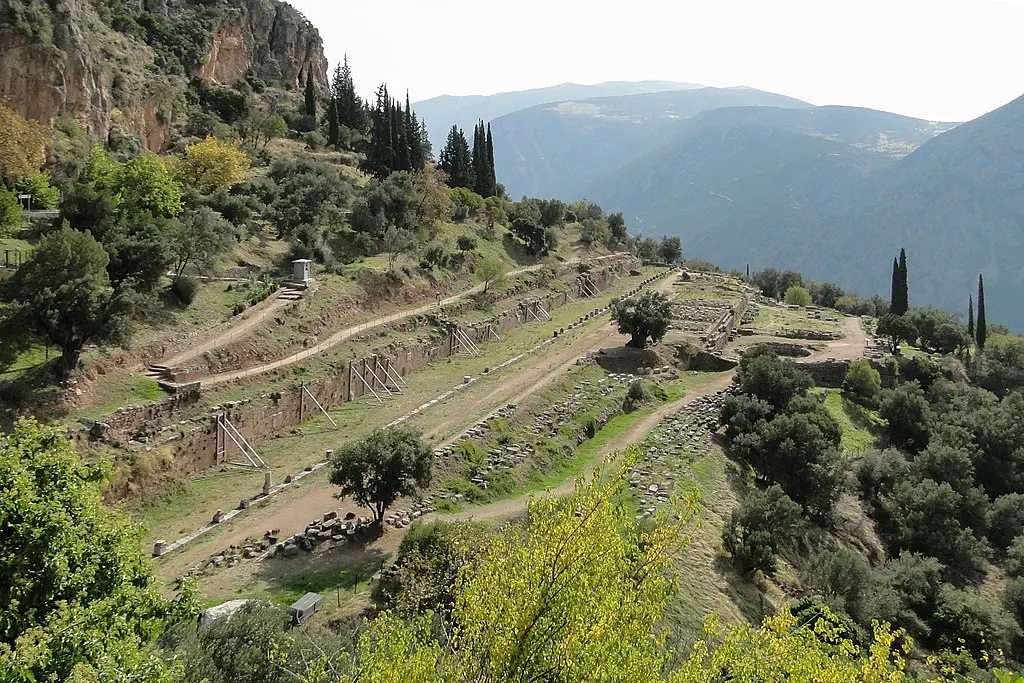
11. Lap Around the Ancient Gymnasium of Delphi
The Ancient Gymnasium of Delphi was a prominent educational institution in ancient Greece and was designed to train young men both physically and mentally.
The gymnasium at Delphi was of considerable size, extending over 178 m (583 ft) in length and featuring a central courtyard. The layout was split into two main areas: the xystos, a covered area designated for running during winter months, and the paradromis, an uncovered space used in the summer. Both areas were equipped with long stoas (colonnades) where philosophers would often discourse.
The gymnasium was also equipped with a palaestra, a wrestling school, and even a bath complex!
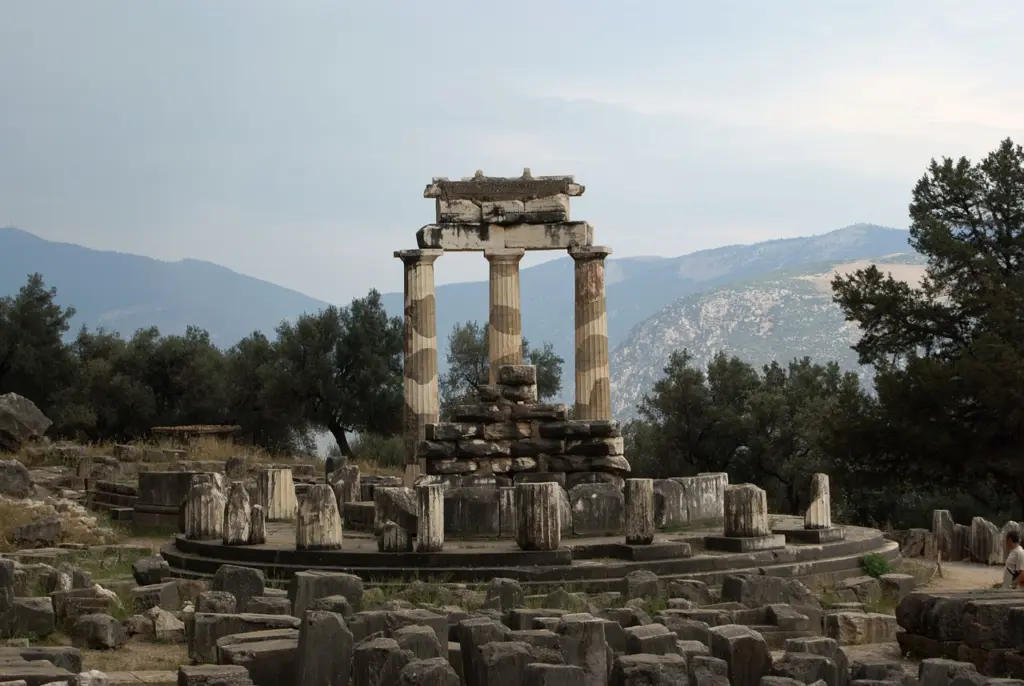
12. Marvel at the Tholos of Athena Pronaia
This sanctuary is situated approximately 800 m (0.5 mi) southeast of the main archaeological site. The Tholos at the sanctuary is one of the most iconic structures of ancient Greece and has become almost as emblematic of Delphi as the Temple of Apollo itself.
Dating back to circa 380 BCE, the Temple of Athena is particularly noted for its stunning design, attributed to the architect Theodorus of Phocaea.
The temple had a circular shape, which was unusual for its time and sets it apart from the more familiar rectangular temples. Its circular design consisted of 20 Doric columns on the outside and 10 Corinthian columns on the inside. The columns have a height of about 4 m (13 ft), and the temple itself had a diameter of approximately 13.5 m (44 ft).
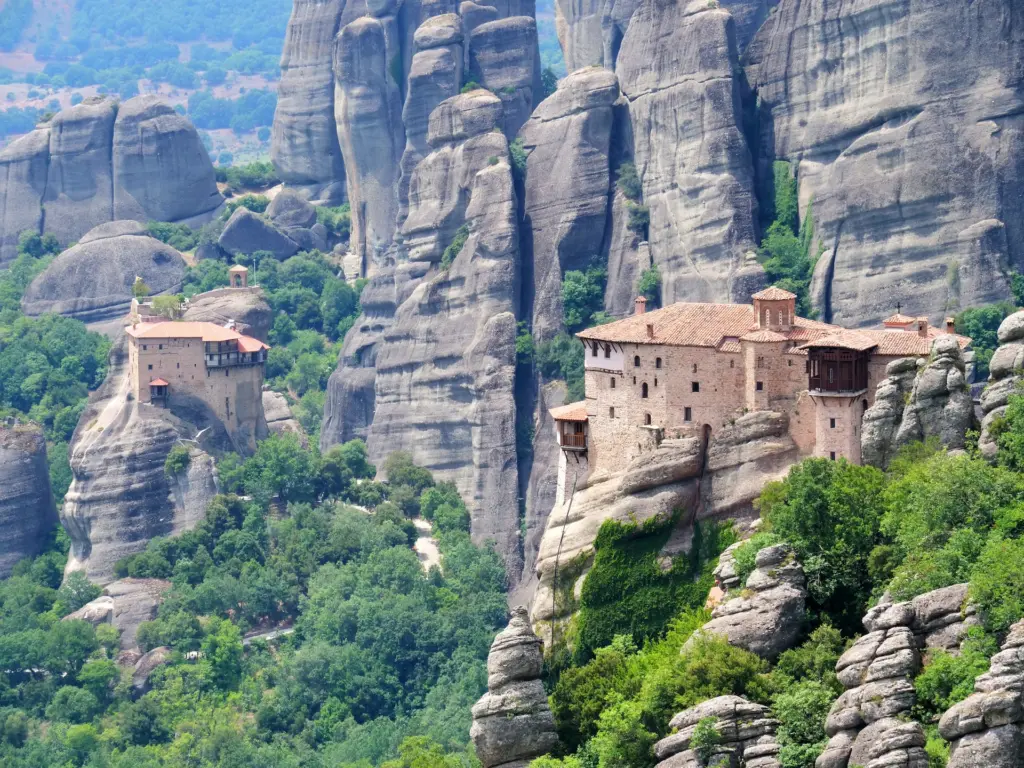
13. Visit Meteora
One of the most otherworldly and breathtaking places in Greece, if not the world, is Meteora.
Although it’s not located within the immediate proximity of Delphi, it’s certainly worth the extra effort to visit if you’re already in the central part of the country. Situated approximately 238 km (147 mi) north of Delphi, a drive to Meteora would take about 3.5 hours via the E65 and EO3 routes.
While the journey may be longer, the awe-inspiring landscapes and monumental rock formations that await you make it completely worthwhile.
Meteora is renowned for its complex of Eastern Orthodox monasteries (Greek Orthodox), precariously perched atop towering, sandstone pillars. There are six active monasteries today, originally built by monks seeking spiritual isolation and freedom from religious persecution. These monasteries date back to as early as the 14th century and are accessible by staircases and pathways cut into the rock formations.
In 1988, Meteora was designated a UNESCO World Heritage site, not just for its religious and cultural significance, but also for its outstanding natural beauty. If it’s too difficult to plan a trip to Meteora by yourself, you can also opt to join this highly-rated tour to Meteora.
Where to Stay in Delphi
The central town of Delphi offers you a quaint and laidback ambiance with a dramatic backdrop of picturesque mountain ranges and rolling hills. To stay in Delphi is to experience the grandeur of the Greek countryside, stunning sunets, a star-filled skies. Here are some of the best places to spend a night or two:
Best Hotels in Delphi:
- Delphic Horizons – offers garden-view accommodations with a balcony, coffee machine, and complimentary Wi-Fi, situated a short 12-minute walk from the Archaeological Museum of Delphi. The apartment boasts 4 bedrooms, a bathroom, a flat-screen TV with streaming capabilities, a fully furnished kitchen, and a terrace overlooking the sea.
- Kastalia Boutique Hotel – boasts an open-air terrace with breathtaking views of Parnassus and provides free WiFi throughout. Its spacious rooms are equipped with balconies, air conditioning, TVs, and tiled-floor bathrooms. The hotel’s restaurant features a terrace overlooking the valley and sea, offering a buffet breakfast, salads, snacks, homemade local dishes, and desserts, complemented by a selection of local wines.
- Delphi Villa Terracotta – nestled in an area popular for skiing, this air-conditioned villa boasts 3 bedrooms, a kitchen with a dining area, and 3 bathrooms with showers. You can relax on the villa’s terrace and benefit from free private parking and a garden on the property.

How to Get to Delphi
- Rental Car or Personal Car: If you opt for the ultimate freedom of a rental car, expect a journey traveling on the National Road Athens-Lamia, which is generally in good condition. The drive usually takes about 2.5 to 3 hours. Factor in fuel costs, ranging between 30 – 45 EUR, and tolls, which could add another 30 EUR for a round trip.
- Public Bus KTEL: For those who prefer public transport, KTEL buses depart from the Liossion bus terminal in Athens and go directly to Delphi. One-way tickets are around 16 EUR, and the journey takes about 3 to 3.5 hours. The buses are equipped with air conditioning, so the ride should be comfortable.
- Group Tours: There are numerous day trips from Athens to Delphi. These guided tours often include commentary, lunch, and entrance fees to various sites. You can a highly-rated tour to Delphi through here.
- Service Taxi: Another option is to hire a car service. While this is a more expensive option, costing upwards of 200 EUR one-way, it offers a personalized and convenient experience.
- Train & Bus: Though there’s no direct train service from Athens to Delphi, you could take a train to Livadeia. From Livadeia, you can take a local bus to Delphi. The total time for this journey would be around 4 to 5 hours and could cost around 40 EUR in total.
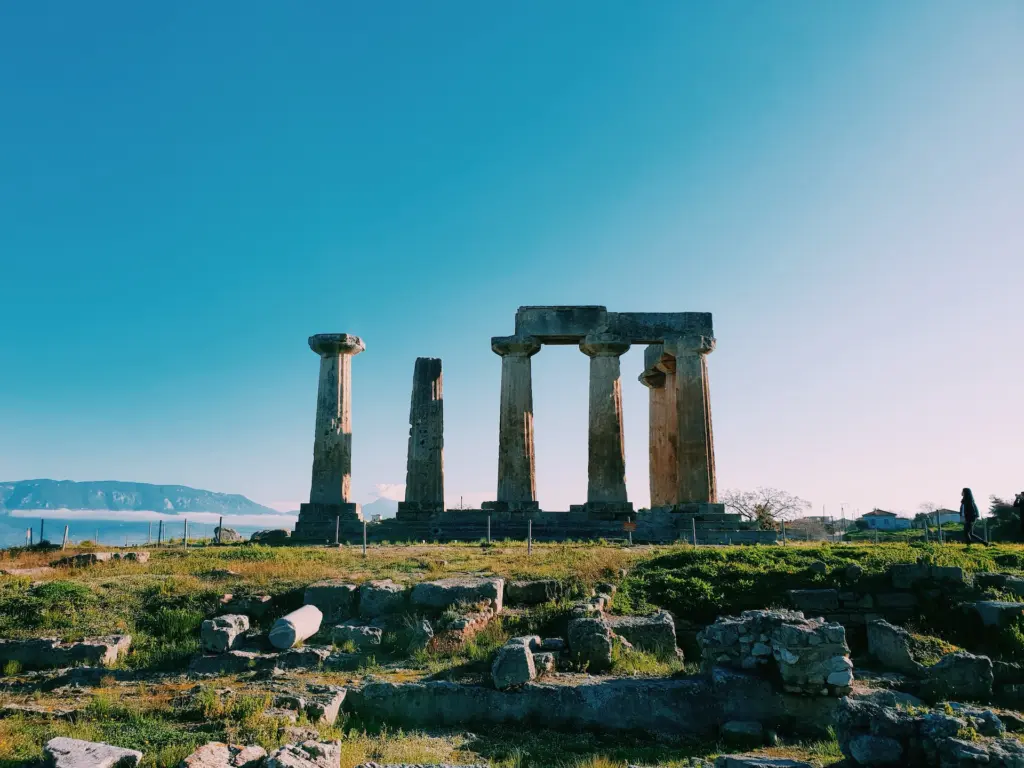
Best Time to Visit Delphi
The optimal time to experience Delphi in all its ancient splendor is during Spring (Mar – May). This season offers mild temperatures and fewer tourists, ensuring a serene exploration amidst blossoming flora. Though we were there during Summer and found there to be very few tourists, perhaps because we had arrived already late in the afternoon.
And to ensure your journey remains hiccup-free, I highly recommend SafetyWing for travel insurance, known for its traveler-focused plans.
Plan Your Trip to Greece | Best Travel Resources
Book Your Accommodations
- Booking.com – the world’s leading online booking platform for accomodations around the world, they have an extensive amount of available listings with zero booking fees and best price guarantees.
- Hostelworld – a backpacker’s best friend, Hostelworld has the largest collection of hostels and guesthouses for affordable prices.
Don’t Forget Insurance
- SafetyWing – from Nomad Insurance, an insurance by nomads for nomads. They understand our lifestyle well and have really comprehensive and flexible plans that cater to any traveler.
Find Cheap Flights
- Kiwi.com – my go-to for booking and finding the cheapest flights and it’s helped me save tons of money. They do virtual interlining which is connecting flights from airlines that do not codeshare, so you can find routes that you wouldn’t be able to find normally.
Join Tours & Activities
- GetYourGuide – is one of the best places to find unique tours and activities. I found that it’s an excellent way to meet fellow travelers and create fond memories. They are not only limited to tours as they also offer niche services such as skip-the-line tickets or private transfers.
Catch a Ride
- Rentalcars.com – nothing beats the freedom of the road, Rentalcars.com is the world’s largest online car rental service. They operate across 160 countries so they’re the perfect partner to work with if you find yourself wanting a ride.

